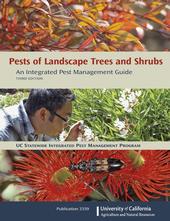- Author: Jeannette E. Warnert
![Brown marmorated stink bugs. [USDA]](https://ucanr.edu/blogs/UCIPMurbanpests/blogfiles/34857small.jpg)
From the UCANR Green Blog
Scientists are rearing tiny Asian wasps in quarantine and evaluating whether they can be released in California to battle brown marmorated stink bug (BMSB), an invasive pest that poses a serious threat to the state's $54 billion agricultural industry, they reported in the current issue of California Agriculture journal.
The wasp, Trissolcus japonicus, has scientists feeling hopeful, said Chuck Ingels, UC Cooperative Extension advisor in Sacramento...

Completely revised and expanded, Pests of Landscape Trees and Shrubs, 3rd Edition, is a comprehensive, how-to integrated pest management (IPM) resource for landscapers, arborists, home gardeners, retailers, and parks and grounds managers. This easy-to-use guide covers hundreds of insects, mites, nematodes, plant diseases, and weeds that can damage California landscapes.
The book's 435 pages present the practical experience and research-based advice of more than 100 University of California (UC) and industry experts, including:
• Pest-resistant plants and landscape design:
• Planting, irrigating, and other cultural practices that keep plants healthy:
• Conserving natural enemies to...
![Adults and nymphal instars of bagrada bug. [S.K. Dara]](https://ucanr.edu/blogs/UCIPMurbanpests/blogfiles/34773small.jpg)
The Bagrada bug, Bagrada hilaris, a colorful stink bug much smaller than the brown marmorated stink bug, prefers to feed on crucifers. It is a seed and bud feeder that can be very damaging to cole crop vegetables such as broccoli and cauliflower. In the landscape it can become very abundant on alyssum, stock, candy tuft, and mustards. The best strategy for landscapes infested with this pest is to replace alyssum and other hosts with alternative plants that it does not feed on.
In the United States, the bagrada bug was first found in Los Angeles County in 2008. By 2011, the pest had disseminated throughout Southern...
![Adult (top) and mature nymph of the brown marmorated stink bug. [S. Ausmus]](https://ucanr.edu/blogs/UCIPMurbanpests/blogfiles/34755small.jpg)
The brown marmorated stink bug (Halyomorpha halys) or BMSB is a new invasive pest of urban and suburban homes and landscapes in California.
A native of Asia, the brown marmorated stink bug immigrated into the United States in the 1990s but has only recently been reported in California. The bug prefers to feed on seeds and fruits, so is most damaging to fruit crops; however, it is a polyphagous feeder that may feed on fruit, leaves, or seeds of many ornamental plants as well.
Landscape managers may become most aware of this new pest in the fall when it aggregates in very large numbers on trees or within dwellings, often becoming a nuisance pest.
For more information about the brown marmorated stink bug, read the...
- Author: Karey Windbiel-Rojas
- Author: Anne Schellman
![Big periwinkle, vinca major. [J. M. DiTomaso]](https://ucanr.edu/blogs/UCIPMurbanpests/blogfiles/34678small.jpg)
Did you know that every 60 days, California gains a new and potentially damaging invasive species? Once established, invasive species are extremely difficult to eradicate and can cause not only ecological disruption, but economic problems as well.
This week (February 21-27) is National Invasive Species Awareness Week. The goal of the week is to raise awareness and identify solutions to invasive species.
What is an invasive species? The term “invasive” is often used to describe something that appears to be taking over a garden or landscape. However, according to the National Invasive Species Council, a true invasive species is...


